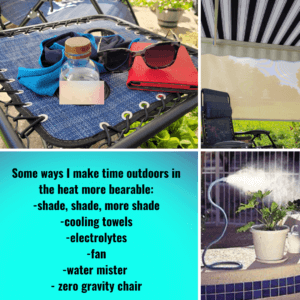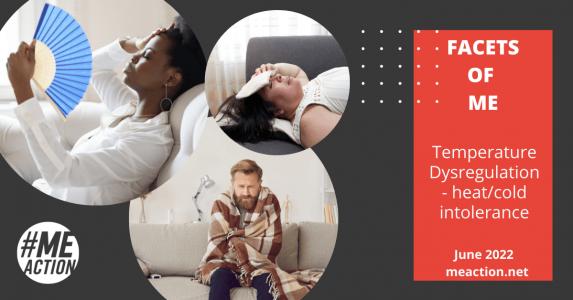Welcome to June’s #FacetsOfME! Facets of ME is an educational feature where we dive into a particular aspect (or facet) of ME and explore it more in depth. This month we are focusing on temperature dysregulation- heat and cold intolerance. It is surprising how difficult this symptom can be to manage until you experience it. Jackie summarized it well: “I think people think “temperature dysregulation” is just “not liking the hot or cold” like everyone else, but it’s actually major problems cooling down in Summer and heating up in Winter. If I get too hot or cold it takes me hours to get back to a normal temperature, something healthy people can do in minutes. My functionality is extremely reduced.” Another community member (M) shared that this was one of the worst symptoms for them. And Melissa shares, “So much thought and energy goes into managing temperature dysregulation. It is one of the most demanding, and yet least talked about symptoms of Long Covid.”
What causes it?
“There are many potential mechanisms at work in people with ME who have issues regulating their body temperature,” says Jaime Seltzer, #MEAction’s Director of Scientific and Medical Outreach, “and these mechanisms likely overlap in the same individuals. Many people with ME have small fiber neuropathies, which contribute to issues with temperature regulation. Poor circulation due to low blood volume, seen in people with ME, may be a contributing factor. Many people with chronic inflammation have “the anemia of chronic illness”, which may affect temperature regulation through three, overlapping mechanisms. And of course, damage or inflammation to the spinal cord or central nervous system can cause issues with temperature regulation, and is seen in Parkinson’s and MS as well as ME.”
You can see more information on the pathophysiology behind the issues in thermoregulation at Mepedia in a recently updated entry here.
Is it required for diagnosis?
International Consensus Criteria (ICC), Canadian Consensus Criteria (CCC), and National Academy of Medicine (NAM) criteria allow for the symptom but do not require it for diagnosis. In CCC it is recognized as a neuroendocrine symptom and in the ICC loss of thermostatic stability and intolerance of extremes of temperatures are separate diagnostic criteria. In NAM, it is not one of the major symptoms but it can fall under orthostatic intolerance and can also fall under neuroendocrine manifestations listed in other symptoms.
Do you just have to live with it?
Not necessarily. Read through the pathophysiology info linked above. Discuss it with your healthcare provider. Depending on what is causing your temperature dysregulation, there might be treatment that can help. Treatable things might include thyroid hormone disorders, small fiber neuropathies, neuroinflammation (anti-inflammatories may help), iron levels and B levels (people with anemia can be freezing cold, etc).
We received an extensive amount of suggestions from our community for the interventions and coping mechanisms that can help make these symptoms easier to bear. So we will not add those separately here. Head to the next section for those!
Community Experiences and Tips
Our community had a lot of wisdom to share! Experiences and tips to help us all understand and cope better. Take a look!
“My ‘body thermostat’ doesn’t work right, but it does seem to follow a pattern. I put on warmer clothing in the morning because I’m always cold. Mid evening I change to lightweight clothes (PJs) and blankets that I can pull on and off all evening, every evening due to internal heat waves. During crashes, I use the evening routine all day.” – Lanetta
“I live in Texas and even though my car has AC I’ll take a cooling towel or washcloth with a bottle of water with me to help keep cool, especially if I get stuck in traffic or waiting for school pick lines the heat can get to me quickly. A cold water bottle or ice pack to the neck helps too.” – Kat
“Shivering with chills & feverish for hours last night during major Crash T=97.6!” – Alice
“I am very cold even in 90 degree weather I can have goosebumps. My poor family will be burning up in the house cause I can’t tell it’s hot. I’m always so cold.” – Rachelle
“I hide in air conditioned spaces, often with a fan blowing on me. I also have ice packs that I put on the back of my neck to cool down faster and drink a lot of electrolyte (Nuun tabs) and water! I also bought a fan that when I do attempt to leave the house I carry around all summer.” – Carly
“If I have to do something outside, I do it early in the morning. Also avoid the streets, the sun generates strong odors which are poison to my system.” – Omayra
“In Summer I often use a mist/spray bottle to spray water on my body which cools as it evaporates, especially with a fan going. A wet flannel kept in the fridge is a good temporary measure. And I need the air conditioning to really cool me down.
“In Winter, beanies, blankets, a hot water bottle, electric blanket, and heater.” – Jackie
“I have learned the hard way to be strategic. I’m mostly home/ bed bound. I had to buy a tiny fridge to put buy my bed so that I don’t have to try to make it to the kitchen freezer as often. I’m constantly assessing my temperature. How many blankets do I need on my legs? Depends on if the ice pack is frozen, or just cool. What part of my head do I need to put the ice pack on? Better switch to the forehead for a while so my neck isn’t frozen. But, what if I have to go somewhere? Well, how aware of my condition is the friend that’s driving? Can we turn on the air? Or will it be so warm and stuffy that I pass out? Don’t forget to always have emergency ice packs and a blanket in the car. In your purse. Ask your best friends if you can buy a couple of ice packs and just leave them in their freezer for when you visit. Managing my temperature is all consuming and constant. Even as I write this, I have been continuously assessing my temperature.” – Melissa
“If you live in Australia and have a fibro diagnosis you can apply for power bill assistance to help keep your temperature regulated. Also look for large gel mats sometimes advertised for keeping your pets cool, placing one of these under you at night will provide a large amount of cooling. Make sure you try them in the fridge before the freezer to avoid over cooling or use a towel between you and the pad.” – Sammy
“Wireless neck fan, looks like headphones & not super obnoxious sounding. I wear it pretty much anywhere I’ll be outside for a long period of time or if I’ll be moving a lot doing housework, lol” – Cass
“It’s June. It’s Arizona. It’s 100°. It’s me under 2 down comforters. Whatever it takes, heh? I don’t go out often but certainly not without my big woolen sweater.” – Lorraine
“Cooling towel is essential in the summer, I wrap it around my head like a bandana. In the winter I need warm socks and my heat pump on 20 deg and I heat the entire house as I can’t cope with the temperature dropping when I move between rooms.” – Nic
“For cold: foot powder, then up to 3 pairs of socks with lined cabin socks on the outside. I wear the cabin socks with treads to help with balance. I also dress in many layers that I can take off or add back on throughout the day. Hot: electrolyte drinks and water in general, drinking, swimming, getting sprayed with it, etc. If I go somewhere I’ll pack drinks in a small cooler bag with ice packs I can put on my head. Also, I take a 40 oz stainless insulated bottle everywhere I go.” – Heather
“LDN helps me with overall heat regulation (low dose naltrexone). I also spend a lot of time in the summer going to local creeks, pools, etc where I can put even just my feet in and splash water on my pulses.” – Holly
“I have the cold issue more than the hot, here in the uk, so I Found that wearing natural materials rather than manmade fabrics is helpful. 100% cotton long sleeved t-shirts then layering up, and finishing with a natural wool Cardigan. The natural materials help me keep warmer, but also you don’t get that weird horrible sweaty but still cold feeling that you get with manmade fabrics. So natural are way nicer to layer, a bit more expensive, but I find they last longer so it evens out. And finally managed to find some fleece lined cotton joggers online marks and Spencers! Toasty and cosy. Plus a feather duvet that is 3 in 1, there’s a low summer tog, then thicker autumn tog, and when you attach them together it makes a winter high tog duvet. That’s great for spending the day and night under, and is nicer feeling than a madmade filling one (again less sweaty- especially since I get night sweats sometimes) but really warm and variable!” – E.G.
“Don’t know the English word for it … the pillow with wheat in it that you heat in the microwave and put on the part of your body that is cold or hurts.” – KICP
“I enjoy sitting out on my patio when I can but when the heat becomes too much that has to stop. These tips are what I use in the in between- the it is not too hot but is getting close time. I have an awning to give my patio shade (this is new and I am so excited!). I have a cheap fan I leave by the door and bring out with me and plug in at my patio outlet. I also have sunglasses to wear, an zero-gravity chair to sit in with my feet up, and a big cup of electrolytes always. On the hotter days, I add in a cooling towel for around my neck and another new favorite- a mister. This one hooks to the hose and helps cool down the area. I usually put a few potted plants underneath to catch any water that falls right under the mister.” – Holly L.

Thank you so much for your contributions to #FacetsOFME! We’d love to keep the discussion going. Let us know if you have any experiences or tips to add. Let us know what facet of ME you’d like to see in a future feature as well.






8 thoughts on “Facets of ME: Temperature Dysregulation”
Soy muy sensible al calor. Lo que he notado que me ayuda es mojarme la cabeza. Pongo agua en un pañuelo o cintas para la cabeza y me las pongo, cuando notó que me pongo mal me la vuelvo a quitar, lo vuelvo a poner en agua y me lo vuelvo a poner. Esto me es muy útil cuando salgo de casa en los meses de calor.
I am so very grateful for this article! I am adding it to my collection of clear articulate pieces that I can give to (interested) others to explain that I am not “afraid of” or “dislike” heat, that a breeze doesn’t negate 90 degree temperatures, and that an 80 degree outdoor temp (in the shade) is truly my upper limit. It’s difficult to find authoritive articles that explain what happens to me (and why).
The Climsom is a mattress topper which runs water through tubes (think underfloor heating) you can set the temperature hot or cold. Need earplugs and noise cancellling headphones to silence the noise.
Thank you so much for this series! And thank you to everyone who has shared in this and other newsletters! It has been such a tremendous help to me. I’ve tried so hard for so long not to focus on my illness that I have stayed away from following it on social media. But your email about a newsletter drew me in, which drew me in further. After reading your articles and hearing people’s experiences, I am now thinking that by staying away I’ve robbed myself of feeling less alone and less “missing.” Thank you all for pulling me out of that fog. I am so grateful. I hope I can offer to someone else a measure of the reassurance and comfort that I am now feeling.
Hi Andrea, I felt the same way – not actively seeking fellow sufferers, thinking it would make me feel worse. it does a bit, but that soon passes to be replaced by an overwhelming sense of support and reassurance. Its not about strength in numbers, rather it is the feeling of not being so alone as you said and finding strength in shared experiences and copying strategies.
Thank you to everyone for sharing. i really look forward to this series! Grahame
Welcome Andrea. But sorry you’re here because of this devastating illness. I’ve been sick with progressive ME for almost 4 decades. I stayed away from info too like you because I worked hard not to be sick. But now, housebound 8 years and mostly bedbound, I’m part of a collective experience thanks to ME Action. At last, we’re united. There are also Facebook groups for people with ME that can help a lot to give support and receive it.
The Climsom is a mattress topper which runs water through tubes (think underfloor heating) you can set the temperature hot or cold. Need earplugs and noise cancellling headphones to silence the noise.
It’s frustrating that your organization claims that it educates the public but this article uses acronyms such as ICC, CCC and NAM without spelling out what these acronyms mean–as is common practice.
This was my first time on this website and, rather than being informed, I found myself confused and discouraged.
Please, never make assumptions that the public knows what an acronym that you’re familiar means.
Comments are closed.